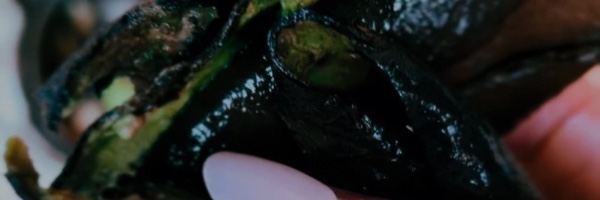Vegetable Dye Using Avocado Skin
Avocado skin dye is a great way to add pink shades to your garments. A pale pink sweater I bought on Poshmark had become quite beige, so I thought this would be the perfect way to (naturally!) add the pink back in. I also had a pink dress that I had Rit dyed years ago to be a bridesmaid for my sister (💖), so I thought avocado dye might help restore or at least refresh the colors.
I used this recipe from NPR as the basis for my dye experiment. Ultimately, I didn’t have or want to track down soda ash, and other recipes didn’t call for it, so I just omitted it. Same thing with alum, which I’m guessing would make the color even more vibrant but wasn’t necessary.
My Final Supplies List

- Six avocado pits and skins, with all the delicious fruit removed (and eaten) and rinsed in cold water
- Large pot with lid
- Laundry detergent – Seventh Generation brand is what I used, but as the NPR recipe notes, any clear unscented soap will do
- Plastic salad tosser for stirring
- White vinegar
The Dye Method
This is the exact method I used, which slightly differs from the original NPR instructions.

- Fill the pot with water. I filled my pot to about an inch from the top. There’s no precise amount of water here, you just need enough water to submerge the garment and a pot big enough to hold that amount of water.
- Add 1/4 teaspoon aka a tiny bit of laundry detergent/ soap. I added a tiny drop on a plastic spoon and stirred in. The idea is to not make the pot overflow with suds.
- Add vinegar. I used white vinegar (the cleaning kind) and splashed it into the pot for one count.
- Boil the water. You should see it turning pink as it heats up.
- Add the garment and turn heat down to a simmer.
- Stir periodically with the tongs.

My At-Home Results
First to be dyed was the sweater. Since it was made primarily of natural fibers (cotton), it really took the pink well, and the color difference was remarkable!


The dress, while the skirt appeared to have a linen texture, was actually mostly polyester, so the dye didn’t ‘take’ at all. I thought it might enhance at least a little but I was mistaken.
Tips for Best Natural Dye Results
OK, this is going to be a no-brainer for some, but straining the water after it’s boiled will help you not get your garment all avocado-eey. That said, you have to have a separate pot or bucket to strain into to do it that way. If you don’t, I recommend a mesh bag to put your pits and skins into at the beginning, that way you can just pull it out at the end.
Wetting down your garment also helps it absorb dye more quickly and more evenly. A quick rinse with cold water will do the trick. I didn’t do that, and the sweater definitely had darker patches. (Maybe that’s why I still couldn’t sell it?)
Rinsing after is also recommended, so the garment doesn’t get crunchy. I thought this would rinse the dye out, but it actually doesn’t. Yes, guys, the dye is permanent so don’t do this in clothes you’d be sad about staining! Washing gently or handwashing will prolong the life of the color, and apparently so does the soda ash I didn’t try.
Bonus: Definitely still compost the skins!

Also… Did you know you can do this whole process with onion for a more orange dye effect? When I try it I’ll let you know how it goes! Both avocado and onion dyes lend well to tie-dye/ Shibori techniques which would be a lot of fun for revamping some clothing.
Happy natural dyeing!

